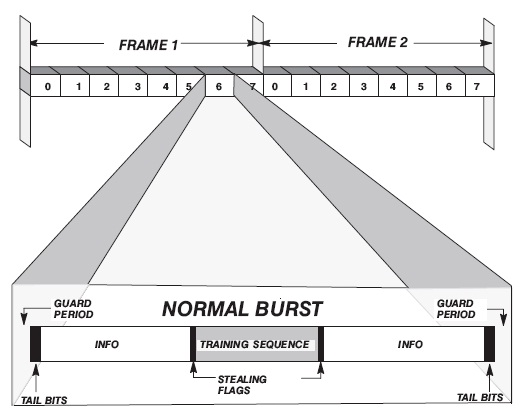What is Burst in GSM and Burst Types in GSM
The Below a GSM burst. It consists of several different elements.

These elements are as below:
This is the area in which the speech, data or control information is held.
Side effects Guard Period
The BTS and MS can only receive the burst and decode it, if it is received within the timeslot designated for it. The timing, therefore, must be extremely accurate, but the structure does allow for a small margin of error by incorporating a ‘guard period’ as shown in the diagram. To be precise no prescription, the timeslot is 0.577 ms long, whereas the burst is only 0.546 ms long, therefore there is a time difference of 0.031 ms to enable the burst to hit the timeslot.
Stealing Flags
These two bits are set when a traffic channel burst has been ‘‘stolen” by a FACCH (the Fast Associated Control Channel). One bit set indicates that half of the block has been stolen.
Training Sequence
This is used by the receiver’s equalizer as it estimates the transfer characteristic of the physical path between the BTS and the MS. The training over the counter sequence is 26 bits long.
Tail Bits
These are used to indicate the beginning and end of the burst.
Burst Types
The diagram below shows the five types of burst employed in the GSM air interface. All bursts, of whatever type, have to be timed so that they are received within the appropriate timeslot of the TDMA frame.
The burst is the sequence of bits transmitted by the BTS or MS, the timeslot is the discrete period of real time within which it must arrive in order to be correctly decoded by the receiver:
Normal Burst
The normal burst carries traffic channels and all types of control channels.
Frequency Correction Burst
This burst carries FCCH downlink to correct the frequency of the MS’s local oscillator, effectively locking it to that of the BTS.
Synchronization Burst
So called because its function is to carry SCH downlink, synchronizing the timing of the MS to that of the BTS.
Dummy Burst
Used when there is no information to be carried on the unused timeslots of the BCCH Carrier (downlink only).
Access Burst
This burst is of much shorter duration than the other types. The increased guard period is necessary because the timing of its transmission is unknown. When this burst is transmitted, the BTS does not know the location of the MS and therefore the timing of the message from the MS can not be accurately accounted for. (The Access Burst is uplink only.)